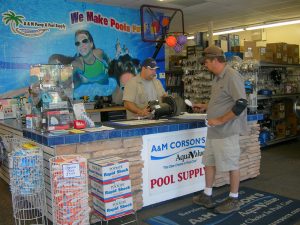Service operations and retailers are always looking for ways to retain and gain customer loyalty whereby stopping their clientele from looking elsewhere for their swimming pool and spa/hot tub needs. One way of doing this is to establish a customer loyalty program that helps service operations and retailers develop long-lasting relationships with their customers, which is a key part of any business plan.
Where should this plan start and how are these programs created to entice consumers to regularly return, whether they are making online or in-store purchases? In most cases, service operations and retailers do not know where to start or are afraid of creating too much work, or worse, creating unnecessary expenses that cut into overall profits. For those service operations and retailers considering the idea of a customer loyalty program, this article provides tips on how to create, implement, and operate a successful program.
Getting started
There are three primary items to consider when building a customer loyalty program:
- What are the business goals?
- What will the structure of the program look like, what items (i.e. products, services) will be included, and how will the points be redeemed?
- How will the program be integrated and implemented into an existing accounting and point-of-sale (POS) system?
Business goals
Depending on what wants to be achieved, the structure of the program should reflect the business goals. For instance, many pool and hot tub retailers state the first reason for setting up a loyalty program is to keep customers from buying commodity pool/spa supplies from big box stores. These retailers want to provide consumers with a reason not to purchase these items at the local supermarket while they are grocery shopping, but rather at their store by rewarding them for the purchase.
One company that set up a loyalty program for this very reason is A&M Corsons, a six-store retail operation in Phoenix, Ariz.
“We set up a loyalty program when we discovered our customers were picking up chlorine tablets at their local grocery store,” says Cerah Gray, the company’s promotions manager. “Our goal was to get our customers to think twice before purchasing commodity items at the grocery store, because we were offering them a benefit to purchase at our retail stores.”
Other reasons why some retailers might be interested in establishing a loyalty program is to expand their customer base by reaching out to a different geographic region or because the company has added a service department and is looking to grow that business.
“Selling cleaning and maintenance services during our off-season is one of our key business goals,” says Alex Soubliere of Friendly Fires, a retailer of barbecue and fireplaces with three retail locations in Peterborough, Kingston and Cobourg, Ontario. “We fundamentally believe that increasing our relationship with our current customers provides the greatest growth for our company. A loyalty program for our business means repeat sales and referrals from our existing customer base, and this has been key to our business success.”
Structuring the program
Retailers can make the loyalty program as simple or complex as they want. Most will agree; however, the simpler it is the better it will work. For instance, most consumers are already familiar with the loyalty programs offered by their local grocery store and/or gas station; therefore, modelling the program after one of these simple platforms can help prevent consumers from becoming frustrated or confused.
When developing its program, A&M Corsons started by researching existing platforms by focussing on those that would not affect the company’s profit margins. By looking at the various programs being offered in the marketplace, it can help a company develop a program that consumers are familiar with.
It is also a good idea for retailers to check with their product suppliers to see if they offer such a program as it can be used to help get things started.
It is also important to determine which items are to be included in the loyalty program. For example, many retailers will allot points to ‘recurring’ sales items (e.g. chemicals), but exclude one-time, large-ticket items such as hot tubs. Points can also be rewarded to retailers based on set dollar amounts.
A&M Corsons, for example, opted for a simple, three per cent discount that is rewarded to their customers once they reach a $350 threshold (this is equal to $7.50). Retailers should be sure to pick a discount level they are comfortable with when starting out. For example, a retail store with average margins between 30 and 40, or even 40 and 50 per cent, may not want to offer more than 10 per cent to keep their customers coming back regularly. A loyalty program should increase the company’s sales, not make it less profitable.
It is important to refer to the company’s goals when determining what items/services to include in the program, which will allow customers to accumulate points. Some businesses do not award points for service work or other larger shop-related jobs, while those retailers looking to expand their service departments will.

To compete with big box stores, smaller specialty retailers need to capitalize on the value-added benefits they offer such as knowledgeable customer service and sales staff, differentiated warranties, and loyalty programs.
Once the business goals and structure (i.e. how points can be earned and redeemed) of the loyalty program has been determined, it is then time to figure out how it will be integrated and implemented within the company’s existing accounting and POS system.
One way for retailers to maximize their loyalty program is to figure out ways of reminding customers of where they stand and what they can obtain with the points they have earned. Therefore, the receipts printed from the POS system should indicate both the total number of points earned and possibly what awards can be obtained with accrued points.
Without a business management software program, it is best to keep the loyalty program simple by using punch cards such as ‘Buy 10 get one free’ on a specific product. Consumers are familiar with these customer loyalty programs when buying consumable goods such as coffee, pizza slices, sandwiches, etc. Another example would be to offer ‘Spend $200 and get $10 off your next purchase.’
System integration
Retailers that do not have business software that can easily track customer loyalty accounts will find it very time consuming to do so manually. Some POS software programs will do this automatically, so all the retailer has to do is select the program type and pick the items that will be included in the loyalty program.
A&M Corsons has had a customer rewards/loyalty program in place for almost five years and they have used both manual and automated approaches.
“We originally started our program within QuickBooks and found it worked well as it was built-in. The best part was it printed the customer’s points on their receipt, making it transparent to the customer,” said Gray. “However, we have operated the program manually as well by tracking everything in Excel. In our manual system, we pulled reports into Excel and combined the data with all of our sales information and then entered the credits back into our system. It’s basically two reports.
“This method requires some work on the part of our accounting department, and we keep the balances in the customer notes. This is not ideal, but as we transition into our fully integrated software system, it’s a method that works.”
Redeeming loyalty points
Most consumers like to accumulate points on every purchase; some may even get upset when certain items are excluded. Keep in mind, the ultimate goal is to encourage regular in-store and online visits; therefore, successful programs tend to have larger point figures that equal a cash value (recurring) or discount amount.

The ultimate goal of a customer loyalty program is to encourage regular in-store and online visits; therefore, successful programs tend to have larger point figures that equal a cash value (recurring) or discount amount.
Recurring loyalty programs are the easiest and coupons are a good way to reward the customer’s loyalty. Some retailers choose a ‘credit’ or ‘credit memo,’ however, be sure to keep an eye on the totals so the books are not loaded with this type of credit—which is not something ‘owed’ to the customer, rather a benefit to the customer for their loyalty/purchases. It is also important the loyalty program includes some ‘lag time’ between when the consumer reaches the point threshold and when they are permitted to redeem them. This is vital as retailers do not want to have someone purchase a product, use the reward, and then bring it back within the 30-day return period. To account for this, many retailers set their program’s provisions to not apply any points from recent purchases to customer accounts until after 30 days.
Gray offers another tip. Rather than allowing customers to continually accumulate credits in their account, retailers should put an expiry date on them (e.g. six months to a year) as this eliminates accounting system problems, especially when a one-time customer purchases a high-ticket item but never returns. Further, by having an expiry date, it gives retailers a reason to reach out to these customers and invite them to the store to redeem their points before they expire.
“We currently have approximately 15,000 reward members and reminding them that their credits are about to expire can be a monumental task,” says Gray. “However, through our new integrated software program, the system allows us to generate a report to see when customer credits are about to expire for easy follow-up with these program members.”
Finally, loyalty points can also be used as a great customer service tool. For example, should a retailer want to compensate an angry customer they can offer them an extra 100 loyalty points. This offer can help better the situation by making the customer feel good and the retailer is not actually spending any money to remedy the complaint. This can be a great customer service tool for retail employees to keep in their back pocket.
Signing them up

Retailers often hold ‘special events,’ ‘open houses,’ and/or ‘sales events’ where they heavily promote their loyalty program to add new customers into the database.
In doing so, Gray suggests retail staff should be well-trained on the loyalty program so they do not oversell any of its benefits or misrepresent how it works. Further, customers should not be automatically enrolled without a verbal and written explanation as well.
The loyalty program should be promoted using a counter card (placard) set up at the POS. The checkout screen should also prompt all employees to ask the customer if they want to become a member of the program. Some POS systems will even allow retailers to use their customer’s existing loyalty cards (e.g. a grocery store keychain barcode) so they do not have to provide a new card to the customer—especially if they do not want to carry another card on their keychain.
“We are still in the initial stages of creating a loyalty program, but have done a lot of database mining in the past,” says Soubliere. “Bringing customers in for barbecue classes have proven to be a successful way to develop loyalty and keep our customers visiting our stores. Signing customers up for a loyalty program as the class ends, along with giving them a bonus or special reward, is an ideal time to build more loyalty with the customer.”
Tracking the results
To ensure the program is meeting the company’s business goals it is important to monitor and check the results frequently to ensure it is working, whereby sales are higher and margins have remained the same. It is also a good idea to compare results before and after the loyalty program was implemented.
“We have found our $7.50 customer credit doesn’t actually cost us $7.50, but rather approximately 1.5 per cent of our cost per credit,” says Gray. “However, customers still perceive the credit as a value and the program has helped to increase sales from those customers whose purchases had previously started to drop.”
Retailers should also take a quick, periodic look at their top 100 customers to see if they are visiting more often, purchasing more since the loyalty program was implemented, in addition to buying the products the retailer is trying to move. Further, for retailers who operate more than one store, with one being in a lower-margin region, the loyalty program should be structured differently for that store to avoid eroding profit margins.
Additional ideas
One way for retailers to maximize their loyalty program is to figure out ways of reminding customers of where they stand and what they can obtain with the points they have earned. For instance, those retailers with the right amount of employee-power should consider e-mailing coupons to their customers, which detail their account information.
Other options such as punch cards—similar to the buy 10 coffees and get one free program—are manual and may help business, but today, most people do not want to carry around a piece of paper. It can become a nuisance and can cause a customer to get upset if they lose their card as there is no way to track what they have purchased. That said, retailers that are more interested in setting up a program that requires the least amount of time and employee interaction should incorporate it into their business software program, whereby making it easier for all employees to promote and use.
This article was written by Christina Braks and originally appeared on Small Business Trends [link].
